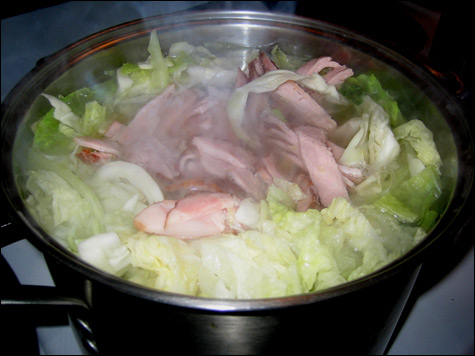
STEWING AWAY Cabbage and pork fill the pot. |
In just a few short days, the life of Saint Patrick will be celebrated the world over with his namesake holiday, Ireland's most visible mark on the global calendar. People raise a glass and call in sick to work the following day to celebrate his lasting gift: a day-pass to act like a drunken idiot. Patrick, by all accounts, was keen on evangelizing to the heathens, so perhaps we have something still to learn.First up: Corned beef and cabbage has not long been the standard dish we conceive it as. Beef, especially in past generations, was available only to the aristocracy. Pork is, and always will be, the protein of the Irish people. So, it is far more likely to see bacon and cabbage making an appearance at an Irish family table.
But this isn't the bacon we know. American bacon, also called "streaky" bacon, generally comes from the belly of the pig, and is generously marked with stripes of fat running adjacent to the "rind," or skin. Irish bacon is unsmoked cured pork loin, much leaner and more like ham. But because we are across the pond from the Motherland, Irish bacon is hard to find, and if you manage to, it's quite expensive. (All my Irish friends confirm that finding it around here is next to impossible.) As a substitute, use a much more affordable two- or three-pound pork roast, like a Boston butt shoulder roast. Plan ahead and brine your roast overnight in a gallon of water with three cups of kosher salt. After brining, boil the roast in its brine for 10 minutes, then drain the brine out and put in enough fresh water to cover the meat, adding a few heads of garlic and a handful of peppercorns. Boil it for three hours, and at the end, add a head of chopped cabbage and about a pound of chopped carrots. Boil until the vegetables are tender. Serve with a bit of the cooking juices and a toothy, pungent prepared mustard.
For a side dish, this take on cakes uses another quintessentially Irish ingredient. Shred several potatoes, using a box grater or food processor. Place the shredded potato in a colander lined with a dish towel or paper towels, and remove as much moisture as possible. Mix in some chopped kale that has been shocked in boiling water for 30 seconds to a minute, then immediately cooled in ice water. Use one egg and two tablespoons of all-purpose flour for every three cups of shredded potato. For good measure, add some melted butter, salt, and pepper, and mix well. Place the mix in spoonfuls on a medium-hot griddle or frying pan. When making cakes with fresh shredded potato, the most important factor is pressure. Place a cast-iron frying pan on top of the cooking cakes, greasing the bottom with some cooking spray. Brown the cakes on both sides, flipping only once, and finish them in a 350-degree oven for 10 minutes. Serve with some fried leeks, or alternately, a relish of sautûed leeks and mustard.
And, of course, it wouldn't be a holiday without a spirit. Irish whisky is often (and wrongly) maligned as a poor, less refined cousin of Scotch. At $21.99, Clontarf has all of what you might want in a fine whisky: vanilla, oak, toffee, a wisp of smoke, and a low price tag.
Todd Richard can be reached at tmr@maine.rr.com.